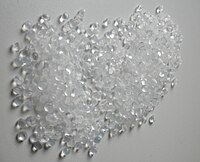
Photo from wikipedia
We fabricated high-performance supercapacitors based on activated carbons (AC) derived from Polyethylene (PE), which is one of the most abundant plastic materials worldwide. First, PE carbons (PEC) were prepared via… Click to show full abstract
We fabricated high-performance supercapacitors based on activated carbons (AC) derived from Polyethylene (PE), which is one of the most abundant plastic materials worldwide. First, PE carbons (PEC) were prepared via sulfonation, which is reported solution for successful carbonization of innately non-carbonizable PE. Then, we explored the physico-electrical changes of PECs upon a chemical activation process. Interestingly, upon the chemical activation, PECs were converted ACs with a large surface area and high crystallinity at the same time. Subsequently, we exploited PE-derived ACs (PEAC) as electrode materials for supercapacitors. Resultant supercapacitors based on PEACs exhibited impressive performance. When compared to supercapacitors based on YP50f, a representative commercial ACs, devices using PEACs presented considerably good capacitance, low resistance, and great rate capability. Specifically, the retention rate of devices using PEACs was significantly higher than that of YP50f-based devices. At the high-rate of charge-discharge situation reaching 7 A g-1 , the capacitance of supercapacitors using PEACs was about 70% higher than that of YP50f-based devices. We assumed the carbon structure accompanying both large surface area and high conductivity endowed a great electrochemical performance at the high current operating conditions. Therefore, it is envisioned PE might be a viable candidate electrode material for commercially available supercapacitors. This article is protected by copyright. All rights reserved.
Journal Title: Macromolecular rapid communications
Year Published: 2022
Link to full text (if available)
Share on Social Media: Sign Up to like & get
recommendations!